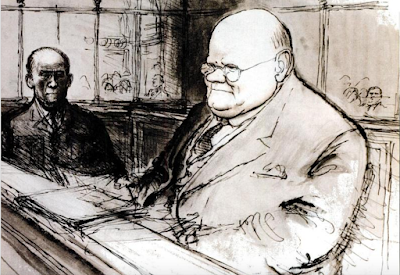Kind words from a man who knows about drawing, cartooning and Ronald Searle. Nick Galifianakis was in L.A. recently on tour with his (co-authored) book on the Art of Richard Thompson and spared a night to have dinner and talk art and travel and, of course, Ronald Searle. I gave him a sneak preview of the book and he seemed impressed and maybe a little excited even . . .
There’s is a code among some cartoonists. A secret handshake, a password that's exchanged. And once that transaction is completed there is an immediate understanding between the parties. Understanding of what…? Of the artist Ronald Searle.
Just such a transaction took place online a few years ago between Matt Jones and myself. Matt, at the time a story artist with Pixar, is the High Priest of the Ronald Searle Religion and the keeper of the best and most thorough blog on the late Searle.
Matt recently found time within his time-consuming regular work schedule to curate an exhibit of Searle's work at the Cartoon Art Museum in San Francisco and, because he’s been able to successfully clone himself, Matt is also completing an extraordinary book on
Ronald Searle In America.
And I can say “extraordinary” with confidence because I was indeed privileged to preview the book over dinner with Matt while on The Art of RT book tour in LA. Peeking at this work in progress is the cartoonist's equivalent to witnessing the creation of the Ten Commandments.
A slight exaggeration.
Slight.
It is a beautiful book, a loving homage to a most brilliant cartoonist - and I know a little something about beautiful books on brilliant cartoonists.
In fact, I'll bring them together with “my” brilliant artist’s own words on Searle. First, some background:
Many of the interviews in The Art of
Richard Thompson were conducted by email, with the interviewers sending questions and Richard answering accordingly. Early in this process, however, Richard broke his hip, an obviously terrible development that slowed down both Richard and the book. So instead, Richard dictated his answers to me.
The good part about this approach was that I could draw upon decades of conversation with Richard, as there was a good chance I’d recall what he had said about this artist or that, and then, when appropriate, nudge him for more. The bad part was that, because of time constraints, this often meant overly taxing my pal during a time when he was quite beat up.
Of course, Richard got even with me because taking dictation from him usually meant, due to his diminished lung capacity, in order to hear him I had to bring my ear to within 2 inches of his mouth, resulting in the side of my face being covered in Cherry Coke spittle and whatever kind of cheeseburger he was eating that day.
Such was the dynamic when Richard was giving me answers to Peter de Seve’s questions about Richard’s influences. Pete was the last of the interviews and the deadline was looming, with a ton of graphics work left on the book, so after prattling on about a variety of artists that left an impression on him, Richard finally said “okay,” indicating that he was through. I looked at him incredulously.
“You’re not done,” I said through my ketchup-sprayed face.
“I’m not?”
“Richard…Ronald Searle?”
“Oh!”
So my exhausted pal gave me two sentences on Ronald Searle. That was it.
“Richard, you’re not stopping at two sentences on RONALD SEARLE!” I exclaimed while picking bits of french fries out of my bushy eyebrows.
Sigh. He dug into his reserves, and gave me a bit more, and stopped. I pushed. And pushed, back and forth…and then Richard unveiled the following thoughts:
“Searle was just such an eye opener. I was twenty, I guess, and I was aware of him, but I didn’t know his work in the fullest…then I got that book, the Searle book with the theater curtain on the front and the binding split because I’d leave it open for reference (meaning copying) more often than it could take…
“For one thing, he could do anything with ink, anything he wanted to, he could do splashy lines, dry brush lines, skippy lines, rapid and staccato lines, stitchy lines … you could feel the weight of history behind his lines, in that he was aware of where they’d been before he used them.
“And the seriousness of some of his ideas… his awareness of art history and such, and that a cartoonist could have that gravitas hand in hand with sublime silliness had not occurred to me.
“Mimicking him was idiotic, but learning from him was necessary. Pat Oliphant said that everyone has a Searle period they go through -- suddenly that’s the only way to draw a lamp or a building or a person or a pig -- you can’t get away from it… until you find your own way, hopefully. Searle was such a gravity well that you could not help but be somehow deformed by his presence.”
I stopped typing before he finished and just looked at my drained friend. Though I’m fully aware that Richard is as eloquent with words as he is deft with his draftsmanship, I am still awed.
The great Ronald Searle inspired the great Richard Thompson, then and now. Matt Jones’ upcoming book is a loving tribute to Searle doing just that, for so many of us.'
Support the book by pre-ordering from Amazon
here

































































































































































